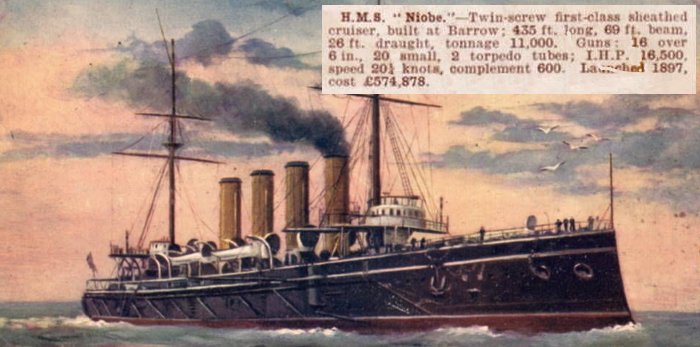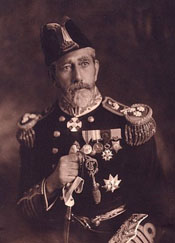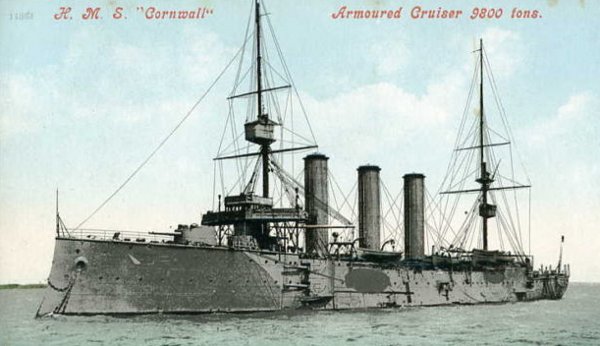Topic: RCN

HMCS Niobe Grounding and Court Martial;
Part 1: The Grounding, 29/30 July, 1911
In 1911, the fledgling Canadian Navy possessed only two capital ships acquired from the Royal Navy. These were the cruisers HMCS Niobe, on the east coast, and the HMCS Rainbow, on the west coast. In late July, 1911, the Niobe was badly damaged when it ran aground on the Nova Scotia coast. Perilously close to being lost, she was saved and spent a year in repairs. Over the next few days, The Minute Book will relate the Niobe's story as it was printed in the papers of the day. We will, start today with the reports of the Niobe's grounding, followed by the court martials held in November, 1911, which tried three officers for the incident.
Lewiston Saturday Journal, 31 July, 1911
Canadian Warship Crashed on Ledges
Boat in Danger for Some Time but Later Floated Off Safely
Halifax, N.S., July, 31.—The new Canadian navy was nearly deprived of half its strength Sunday when the flagship Niobe crashed on the ledges on the southwest of Cape Sable. Five hours later she floated leaking badly and proceeded under her own power to Shag Harbour, ten miles away, where she is at anchor with six fathoms of water and a soft mud bottom under her. The first vessel to reach the side of the disables cruiser was the United States revenue cruiser Androscoggin which was cruising in the vicinity. The Niobe's wireless call for help was picked up by the Androscoggin which promptly flashed back that she would stand by to help and would do all in her power. Through the dense fog and heavy sea, the Androscoggin rushed and was standing by the Canadian cruiser when the steamer Lady Laurier and Stanley which had been sent to the scene, arrived from Westbay with the tug McNaughton of Yarmouth,
The Niobe, however, found that she was able to take care of herself. Although the water was pouring into several compartments her pumps kept fairly clear, and Commander Macdonald, of the cruiser, expressed his thanks to the American cutter for her help, proceeded to a safe harbour convoyed only by the tug.
At Shag harbour divers from the war ship went over the side and placed mattings over some of the larger rents in the hull and if the weather is favourable tomorrow Commander Macdonald is confident that he can proceed safely to Halifax for repairs.
The cause of the accident probably will not be disclosed until it is brought out at an official marine inquiry, which is certain to follow.
It is known that a heavy fog enshrouded the coast, and it is said also that there was a gale of wind blowing. Commander Macdonald and the other officers of the Niobe were non-communicative when queried by wireless for a statement as to the cause of the standing.
The accident, which threatened seriously to rob the young Canadian navy of half its strength (the Niobe, with the cruiser Rainbow, stationed on the Pacific coast, comprise the Dominion's navy) narrowly missed the further unhappy notoriety of bringing about the loss of 16 men. As it was these 16 sailors passed half a dozen hours in two small boats, lost in the fog and at the mercy of a heavy southeast wind which is was feared, would wreck them on one of the many ledges which abound about Cape Sable. But it was learned by wireless Sunday night that all had rejoined their ship in one boat, the other apparently having been wrecked, as was feared.
So extreme was the plight of the Niobe that Commander Macdonald had ordered all the boats cleared away, ready for abandonment of the supposedly doomed ship. The two boats which were lost for a time with their crews were the first launched, launching of the other boats having been deferred until the condition of the vessel had been more definitely ascertained. The Niobe held up on the ledge on 11.25 Sunday morning while rounding Cape Sable from Yarmouth where her officers and crew had been participating in an old home week celebration. The cruiser was feeling her way along the coast cautiously when she struck. She scarcely budged for a long time afterward, the impact being so terrific as to drive her hard into the pinnacle of rock. Everybody was brought up standing.
It was at once appreciated by Commander Macdonald that his vessel was in grave danger. The bugles at once sounded the reveille, bringing tumbling to the deck the whole ship's crew not on duty. More than 300 men were then assembled on deck. True to traditions of the British navy from which Canada's new sea fighting strength sprang, there was no panic. The ship's company found their accustomed posts, and stayed there apparently unmoved. The order to clear away the boats was executed in an orderly manner. There was no hurry manifested.
In response to Commander MacDonald's inquiry made at once after the impact the engineer signalled that water was rushing into the vessel at a rapid rate through a hole under the starboard engine room. Pumps were at once manned and set to work, and it was found that they could dispose of the water.
Then was begun the work of acquainting the outside world with the Niobe's plight, with the hope of securing assistance. The wireless was brought into play, and the operator flashed the "SOS" signal in all directions, with the vessel's position.
The Niobe, which is a protected cruiser of 11,000 tons, is the first vessel purcahased by Canada for its new navy last fall. She is the flag-ship of the little fleet of two, and like the Rainbow on the Pacific coast, is used as a training ship for the navy in the Atlantic.
The Toronto World, 2 Aug 1911
Canadian Cruiser Niobe in Danger of Foundering
Water is Slowly Gaining in the Ship,
in Spite of All the Pumps That Can Be Set to Work
and She May Have To Be Beached

Admiral Kingsmill
Halifax, Aug 1.— The condition of the cruiser Niobe at Clarke's harbour, where she is anchored, is one of grave peril for the warship. A despatch from there to-night says that in spite of all that her own pumps can do and although the pumping apparatus on wrecking steamers is kept going day and night, the water is slowly gaining, and the Niobe is settling by the stern.
This evening not more than ten feet were visible above the surface. The cruiser is anchored in seven fathoms of water, three quarters of a mile off West Head, a point in Clarke's Harbour. A red flag has been set half way between the ship and the shore, marking the most suitable spot to beach the cruiser it it comes to the worst. This would be done in six fathoms of water with a smooth sanfy bottom. The weather continues clear and fine.
One of the holes in the bottom of the Niobe is said to be twenty-five feet long and ten feet wide, One hundred and ninety boys and recruits were disembarked from the cruiser to-day and forwarded to Halifax. The reason given by Admiral Kingsmill for this is that they were only in the way and that as no training was going on it was better for them to be ashore, thus leaving the petty officers free for duty.
Additional pumps and divers were despatched from Halifax to-night in hope of keeping the cruiser afloat and of more quickly determining the exact extent of the damage sustained. The crew is still aboard.
Clarke's harbour is twelve miles from the southwest ledges where the Niobe struck.
Admiral Kingsmill, who commands the Canadian Navy, and who arrived from Ottawa last night, paid a warm compliment on the discipline on board the Niobe when she was ashore on the southwest ledges. Admiral Kingsmill based what he had to say on a letter received today from the Niobe.
"The discipline on the Niobe by the boys and young recruits," Admiral Kingsmill observed, "was everything that one could wish for. With the ship in the position she was, a gale of wind blowing and dense fog over all, the Canadian bots behaved fully up to the traditions of the British Navy. The discipline left nothing to be desired. Of course the ship's crew and officers displayed fine discipline, but I am speaking now of the Canadian boys and recruits."

In a cruel twist of fate, the HMS Cornwall, sent to tow the HMCS Niobe, almost suffers the same fate on ledges near where the Niobe had been stranded.
Meriden Morning Record, 7 August, 1911
British Cruiser is Stranded on Ledges
Halifax, N.S., Aug. 6.—A wireless dispatch received in this city tonight stated that the British cruiser Cornwall is stranded on the ledges of Cape Sable a few miles from the southwest ledges where the Canadian flagship Niobe went on the rocks July 30. The message stated that the Cornwall was not making water and sustained no serious damage.
The Cornwall is an armoured cruiser of 9,800 tons and is now used as a training ship. She has about 300 cadets on board besides a regular crew and was on her way from St John's, Nfld., to Clarke's Harbor to tow the damaged Canadian cruiser Niobe to this city. The Cornwall left St. John's last Thursday after she had returned from a cruise around the Newfoundland coast. The whole coastline was enveloped in a thick fog tonight and this is believed to have caused the Cornwall's stranding. The rock where she struck is about two miles from the ledges which nearly proved the undoing on the Niobe.
